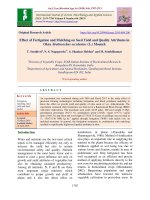Effect of liquid biofertilizers and inorganic fertilizers on yield and quality attributes of broccoli (Brassica oleracea L. var. italica)
Bạn đang xem bản rút gọn của tài liệu. Xem và tải ngay bản đầy đủ của tài liệu tại đây (212.69 KB, 6 trang )
Int.J.Curr.Microbiol.App.Sci (2019) 8(10): 374-379
International Journal of Current Microbiology and Applied Sciences
ISSN: 2319-7706 Volume 8 Number 10 (2019)
Journal homepage:
Original Research Article
/>
Effect of Liquid Biofertilizers and Inorganic Fertilizers on Yield and
Quality Attributes of Broccoli (Brassica oleracea L. var. italica)
M. V. Pawde, A. M. Bhosale and S. J. Syed*
Department of Horticulture, College of Agriculture, VNMKV Parbhani (M. S.), India
*Corresponding author
ABSTRACT
Keywords
Broccoli,
Biofertilizers,
Chemical fertilizers,
Azotobacter, PSB,
Azotophos
Article Info
Accepted:
04 September 2019
Available Online:
10 October 2019
The investigation was carried out at the Department of Horticulture,
College of Agriculture, VNMKV, Parbhani (M. S.) during Rabi 2018-19 to
study the effect of liquid biofertilizers and inorganic fertilizers on growth
attributes of broccoli (Brassica oleracea L. var. italica) Cv. Green magic.
Two factors were taken for study, the first factor was the chemical
fertilizers at three levels (125 %, 100 % and 75 % of RDF) and the second
factor was the different biofertilizers (Azotobacter, PSB and Azotophos).
The experimental design adopted was factorial randomized block design
with 12 treatment combinations. The characters viz., chlorophyll contents
(0.34 mg/100g), ascorbic acid (125.04 mg/100g), total yield per plant
(1268.80 g), total yield per plot (31.72 gkg) and total yield per hectare
(469.97 q) of broccoli were recorded highest with the application of 125 %
RDF + Azotophos. The treatment of 125 % RDF + Azotophos was
significant than other treatments.
Introduction
Broccoli (Brassica oleraceaL. var.italica)
belongs to the family Brassicaceae. It has
thick clusters of flower buds that form edible
heads. These heads are green, purple and
white in color. Broccoli is highly nutritious
and has been considered as anti-cancerous
food by the American Cancer Society because
it contains Indole-3-carbinol which helps to
fight breast and lung cancer. It also contains
flavonoids, phenolic acids and soluble dietary
fiber, diasaccharides, beta carotene and amino
acids (including a high content of lysine) too
and it has antioxidant and anticancer activity
(Podsędek, 2007). It is a good source of
vitamin A, calcium and vitamin B2 and it is
also rich source of most minerals especially of
potassium,
phosphorus,
sulphur
and
magnesium and micro elements (Aboul Nasr
and Ragab, 2000; Sander, 1996). China is the
top world producer of broccoli (FAO, 2009).
In recent years cultivation of broccoli has
gained momentum in India and has become
374
Int.J.Curr.Microbiol.App.Sci (2019) 8(10): 374-379
increasingly popular with Indian growers for
last couple of years. In the recent past,
broccoli cultivation has been taken up
successfully by some farmers around Nasik,
Pune and Thane. Recently it is proved that
broccoli can grow successfully under
Marathwada region.
Application
of
liquid
bio-fertilizers
inoculation in vegetable crops has been of
much significance as Azotobacter and
Azospirillium for atmospheric nitrogen, also
known for synthesis of biologically growth
promoting substances whereas, PSB are
important microbes in releasing and making
available phosphorus by colonizing the root
surface of growing plant root. They also
improve the plant growth due to increase in
nutrient uptake particularly phosphorus, zinc
and other micro-nutrients, production of
growth promoting substances and resistance to
plant pathogen. These bio-fertilizers are
organic in origin and thus, are absolutely safe.
Therefore, it is essential to adopt a strategy of
integrated nutrient management using
combination of chemical fertilizers, organic
manures and biofertilizers, so as to minimize
the cost of production and to maintain
biological productivity of soil, particularly
because the farmers are reluctant to adopt
recommended fertilizer doses due to the high
cost and risk of crop failures on account of
aberrant weather conditions. Hence, keeping
all the points in view, the present study was
undertaken to study the effect of liquid
biofertilizers and inorganic fertilizer doses on
yield and quality of broccoli (Brassica
oleracea L.var. italica) at the department of
horticulture, VNMKV Parbhani.
Materials and Methods
The experiment was conducted at Department
of Horticulture, College of Agriculture,
VNMKV, Parbhani that comes under
subtropical region and is geographically
situated between 19º 16´ N latitude and 76º
47´ E longitude. The experiment consisted of
twelve treatment combinations with three
levels of inorganic (125 % RDF (F1) –
150:100:75 kg/ha, 100 % RDF (F2) –
120:80:60 kg/ha and 75 % RDF (F3) 90:60:45
kg/ha) and four level of biofertilizers (without
biofertilizers (B0), Azotophos (B1), PSB (B2)
and Azotophos (B3). The Factorial randomized
block design was adopted with three
replications. The experimental field was
thoroughly ploughed to a depth of 30 cm and
harrowed twice. The field was laid out at a
plot size of 3 x 2.25 m. The biofertilizers
(Azotobacter, PSB and Azotophos) were
applied by drenching after transplanting of the
seedlings. They were transplanted in ridges
and furrow system at a spacing of 60 x 45 cm.
Standard cultural and management practices
were adopted. Observations were recorded on
yield and quality traits i. e. chlorophyll
contents, ascorbic acid, total yield per plant,
total yield per plot and total yield per hectare
of broccoli. Least significant difference at 5%
level was used for finding the significant
differences among the treatment means. The
data obtained from selected plants were
subjected to analysis of variance Panse and
Sukhatme (1961).
Results and Discussion
Quality parameters
Chlorophyll
Chlorophyll was found maximum with the
combined application of biofertilizers and
inorganic fertilizers. It is clear from the result
that the maximum chlorophyll content was
(0.22 mg/100g) recorded under 100 % RDF
(F2), followed by 125 % RDF (F1). Among
biofertilizers maximum chlorophyll contents
(0.31 mg/100g) was recorded in plants which
were applied with Azotophos (B3). The
interaction treatment of 125 % RDF +
375
Int.J.Curr.Microbiol.App.Sci (2019) 8(10): 374-379
Azotophos (F1B3) had significantly increased
chlorophyll contents (0.34 mg/100g), followed
by 100 % RDF + Azotophos (F2B3).The
increase in availability of nitrogen and
phosphorus might have resulted in greater
content of chlorophyll in broccoli leaves.
Similar results were obtained by Chaudhary et
al., (2017).
Ascorbic acid
The maximum ascorbic acid content (107.14
mg/100g) was found under level of 100 %
RDF (F2), followed by 125 % RDF (F1) and
75 % RDF (F3). Among the biofertilizers
levels the maximum ascorbic acid contents
(119.61 mg/100g) was recorded under
Azotophos (B3) followed by PSB (B2) and
Azotobacter (B1). The interaction of chemical
fertilizers and biofertilizers i.e. 125 % RDF +
Azotophos (F1B3) recorded highest ascorbic
acid contents (125.04 mg/100g) followed by
100 % RDF + Azotophos (F2B3).The
respective increase in ascorbic acid contents
might be due to the increased efficiency of
microbial inoculants to fix atmospheric
nitrogen, increase in availability of
phosphorous and secretion of growth
promoting substances which accelerates the
physiological process like carbohydrates
synthesis etc. Similar results were obtained by
Chaudhary et al., (2017), Shivran et
al.,(2017)and Singh et al., (2018).
Yield parameters
The highest yield per plant (980.90 g) was
recorded in 100 % RDF (F2) followed by 125
% RDF (F1) and 75 % RDF (F3). Among
biofertilizers maximum yield per plant (1198
g) was recorded under Azotophos (B3)
followed by PSB (B2) and Azotobacter (B1).
The interaction treatment of 125 % RDF +
Azotophos (F1B3) showed significant increase
in yield per plant (1268 g) which is followed
by 100 % RDF + Azotophos (F2B3).
This might be due to better root proliferation,
more photosynthesis efficiency, and enhanced
food accumulation, increased availability of
atmospheric nitrogen and soil phosphorus by
microbial inoculants and synthesis of plant
hormones at all the stages of growth and
development by the combined application of
biofertilizers and inorganic fertilizers. Similar
results were obtained by Thakur et al., (2015)
and Panchalet al., (2018).
The highest yield per plot (24.67 kg) and yield
per hectare (371.08 q) were recorded in 100 %
RDF (F2) which was followed by 125 % RDF
(F1) and 75 % RDF (F3). The biofertilizers
Azotophos (B3) level recorded the maximum
yield per plot (29.84 kg) and yield per hectare
(443.68 q), followed by PSB (B2) and
Azotobacter (B1).
The maximum yield per plot (31.72 kg) and
yield per hectare (469.67 q) were recorded in
125 % RDF + Azotophos (F1B3), followed by
100 % RDF + Azotophos (F2B3). The increase
in yield might be due to the nitrogen fixer’s
phosphorus solubilizers, greater availability of
nutrients in the soil and better nodulation
under the influence of inoculation resulted in
better growth and development. Similar results
were obtained by Ramana et al., (2011),
Meenaet al., (2017) and Chaudhary et al.,
(2017).
Interaction of chemical fertilizer and
biofertilizers enhanced the vegetative and
reproductive growth. Therefore, amongst all
the treatments, interaction of 125 % RDF and
Azotophos can be considered as most
beneficial in terms of growth. From the
present investigation it is revealed that, soil
application of chemical fertilizers and
biofertilizers is an instant and effective way of
application which give significant yield and
quality
parameters
of
plant
and
physicochemical properties of curd of broccoli
(Table 1 and 2).
376
Int.J.Curr.Microbiol.App.Sci (2019) 8(10): 374-379
Table.1 Effect of chemical fertilizers and biofertilizers on quality parameters of broccoli
Treatment
Quality Parameters
Factor: – A
Chemical Fertilizers
Chlorophyll (mg/100g)
Ascorbic acid (mg/100g)
F1
0.21
106.91
F2
0.22
107.14
F3
0.19
103.37
SE+
0.01
0.98
CD at 5% level
0.03
2.86
B0
0.16
94.43
B1
0.17
100.97
B2
0.21
108.21
B3
0.31
119.61
SE+
0.01
1.13
CD at 5% level
0.03
3.31
F1 B0
0.16
95.02
F1 B1
0.17
98.57
F1 B2
0.22
109.03
F1 B3
0.34
125.04
F2 B0
0.16
94.44
F2 B1
0.18
103.28
F2 B2
0.23
110.75
F2 B3
0.31
120.07
F3 B0
0.14
93.83
F3 B1
0.17
101.07
F3 B2
0.18
104.85
F3 B3
0.28
113.72
SE+
0.01
1.95
CD at 5% level
0.03
5.73
Factor :- B
Biofertilizers
Interactions (FXB)
377
Int.J.Curr.Microbiol.App.Sci (2019) 8(10): 374-379
Table.2 Effect of chemical fertilizers and biofertilizers on yield parameters of broccoli
Treatment
Factor :– A
Chemical Fertilizers
F1
F2
F3
SE+
CD at 5% level
Factor :- B
Biofertilizers
B0
B1
B2
B3
SE+
CD at 5% level
Interactions (FXB)
F1 B0
F1 B1
F1 B2
F1 B3
F2 B0
F2 B1
F2 B2
F2 B3
F3 B0
F3 B1
F3 B2
F3 B3
SE+
CD at 5% level
Yield plant-1 (g)
Yield per plot1
(kg)
Yield per hectare1
(q)
980.60
986.90
903.10
14.72
43.17
24.52
24.67
22.50
0.43
1.26
362.61
371.08
334.51
5.75
16.85
699.47
908.93
1021.07
1198.00
16.99
49.85
17.49
22.72
25.53
29.84
0.50
1.46
265.74
336.65
378.20
443.68
6.64
19.46
729.20
848.00
1076.40
1268.80
764.40
968.00
1023.20
1192.00
604.80
910.80
963.60
1133.20
29.44
86.34
18.23
21.20
26.91
31.72
19.11
24.20
25.58
29.80
15.12
22.77
24.09
28.00
0.86
2.52
267.85
314.01
398.61
469.97
305.38
358.51
379.05
441.37
223.99
337.43
356.93
419.70
11.49
33.71
378
Int.J.Curr.Microbiol.App.Sci (2019) 8(10): 374-379
References
Aboul, N. H. and Ragab, W. S. M.
(2000).Yield, head quality and
nutritional composition of a new late
flowering broccoli variety grown under
Assiut conditions. Assiut J. of
Agricultural Science, 31(1): 55-77.
Chaudhary, M., Jat, R.K., Chand, P. and
Chaudhary, R. (2017).Effect of
biofertilizers on growth, yield, and
quality
of
knolkhol
(Brassica
caulorapa.L). J. of Pharmacognosy
andPhytochemistry, 6 (6): 2234-2237.
Chaudhary, S., Paliwal, R. (2017).Effect of
Bio-organics and mineral nutrients on
yield,quality and economics of
sprouting broccoli (Brassica oleracea
var.italica).International J. of Current
Microbiology and Applied Sciences, 6
(12): 742749.
FAO statistics, (2009). Production year
book.Food
and
Agriculture
Organization, Rome, Italy.
Meena, K., Ram, R.B., Meena, M.L., Meena,
J.K. and Meena, D.C. (2017). Effect of
Organic Manures and Bio-Fertilizers
on Growth, Yield and Quality of
Broccoli (Brassica oleracea var. italic
P lenck.) Cv. KTS-1, Chemical
Science Review and Letter,6(24),
2153-2158.
Panchal, B.H. Patel, V.K. Patel, K.P. and
Khimani, R.A. (2018) Effect of
biofertilizers, organic manures and
chemical fertilizers on microbial
population, yield and attributes and
quality of sweet corn (Zea mays L.,
saccharata) cv. Madhuri. International
J. of Current Microbiology and
Applied science, 7 (9): 2423-2431.
Podsedek, A. (2007). Natural antioxidants and
antioxidant capacity of Brassica veget
ables.LWT 40:1-11
Ramana, V., Ramakrishna, M., Purushotham,
K. and Reddy, B.K. (2011). Effect of
bio-fertilizers on growth, yield and
quality of French bean (Phaseolus
vulgaris L.).Vegetable Science,38
(1):35-38.
Shivran.B.C., Meena ML., Ola AL.,
Chaudhary. G R, Meena, J. K,
Atal.MK,
(2017).
Impact
of
biofertilizers and zinc on biochemical
parameters of sprouting broccoli
(Brassica oleracea. Var. italica) under
Lukhnow
conditions.
J.
of
Pharmacognosy and Phytochemistry, 6
(6); 2065-2067.
Singh, B., Singh, K.,Talwar, D., Jindal, S.K
and Sardana.V.S. (2018). Influence of
biofertilizers on growth and yield
attributing attributes in tomato.
International
J.
of
Current
Microbiology and Applied science,7
(4); 3686-3694.
Thakur, K.S., Brar, N, S., Kumar, R., Mehta,
D.K., Sharma, N., Kumar, D. and
Kumar, S. (2015). Effect of organic
manures and biofertilizers on fruit
yield and its contributing traits of
tomato (Solanum lycopersicon L.).
Eco.Env.& Cons, 21 (4): 1783-1787.
How to cite this article:
Pawde, M. V., A. M. Bhosale and Syed, S. J. 2019. Effect of Liquid Biofertilizers and
Inorganic Fertilizers on Yield and Quality Attributes of Broccoli (Brassica oleracea L. var.
italica). Int.J.Curr.Microbiol.App.Sci. 8(10): 374-379.
doi: />
379
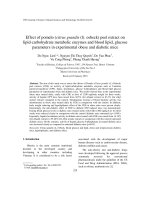

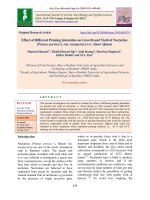
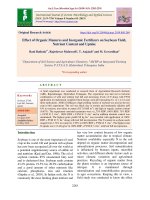
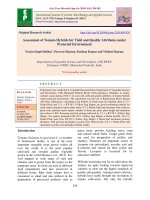
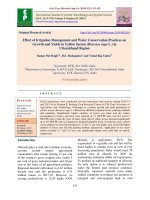

![Effect of integrated nutrient management and bio-regulators on quality attributes of sprouting broccoli [Brassica oleracea (L.) Var. Italica Plenck] effect of Integrated Nutrient Management](https://media.store123doc.com/images/document/2020_01/14/medium_ldn1578943904.jpg)
